Q & A with Eric Iwersen
Last week, I interviewed Eric Iwersen, a Transportation Planner for the City of Tempe. He’s one of the employees who addresses a lot of bicycle-related concerns. Here’s what he had to say about his experiences with bicycling in Tempe and working for the City:
How did you get involved in bicycling?
I grew up in Boulder, Colorado, where biking is how a lot of people get around, so that’s what I did growing up.
So how was it when you started to bike in Tempe?
Well, I’d never been here before. I was basically dropped off with a bike and a skateboard and a class schedule, and then went from there. When I first started bicycling around Tempe, it felt really unsafe. There were very few bike lanes anywhere. It was really different from Boulder, where biking is a regular part of the culture. At that time, I stayed pretty local and took buses a lot, and did most of my hanging out around Mill and the downtown Tempe area.
I hear there’s an interesting story to how you got your job with the City. What happened?
Well, when I was a senior at ASU, I started to organize Critical Mass rides—I think I organized four rides in total during the spring of ’04 (January through April). At the first ride about 25 people showed up, but by the last ride, over 300 people showed up. As a result, I got on the news and was interviewed and in the paper. At that point, I went to the City and talked to different staff members and the Transportation Commission and introduced myself. I didn’t want there to be any animosity between my group and the City—I was trying to do good things for the community. I had a couple of specific goals at that time, mostly to get bike lanes put in on University, Apache, and Mill. I made some people angry but then the City turned around and ended up offering me a position.
So what kinds of things do you do for your job?
As a planner for the City, I work on long-range planning policies (like developing standard details for bicycle racks for businesses), for projects to be implemented over the next 20-30 years. These policies address things like how wide we want our streets to be, as well as how we want our land use to support transportation.
I am also involved in short-range project management—that includes projects at the funded, buildable stage, like the Rio Salado bike path, which I’ve been involved in getting funded and built.
How quickly do such transportation projects get built?
At the very fastest, two years. But usually, from the concept to the construction, the process takes around ten years.
So let’s say someone has a particular question or a brilliant idea about transportation infrastructure, what’s the best way for him or her to work with the City to make things happen?
Well, the quickest and best way is to get political. Talk to your elected officials about the idea. If you’ve got an idea, call the Mayor and ask, why don’t we do this? The Mayor might then suggest talking to the transportation staff. But the real benefit of going political is that even if a staff person ends up handling the response, the Mayor and City Council have an awareness for a citizen’s desire for some kind of change. Elected officials have the most control over what happens with the City, and they need to know what Tempe residents want and what their vision is.
On top of that, you can always volunteer for positions, go to City Council meetings, go to Transportation Commission meetings, and do things yourself. So there are a lot of ways to get involved.
Thanks, Eric. Lastly, how about a fun question: What’s your biggest biking pet peeve?
Uncomfortable government clothing. Someone should really do something about that. I wish we could wear shorts.
Got a suggestion on something we should find out more about? Leave it in the Comments!
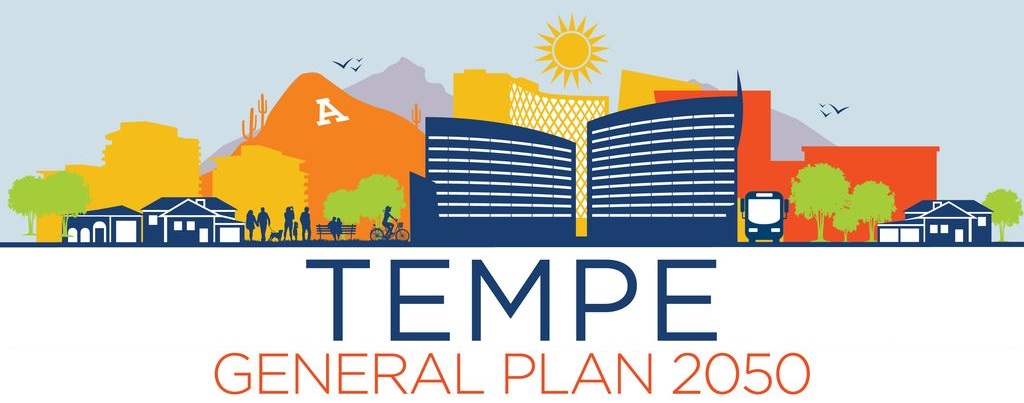

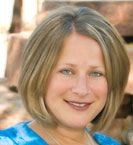
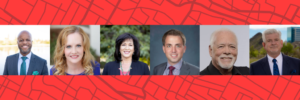
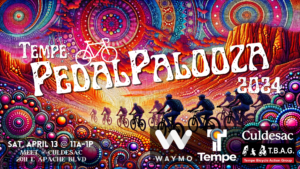
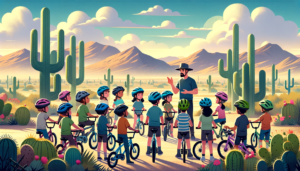
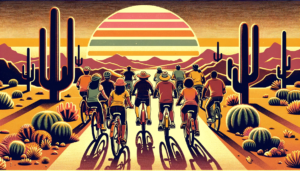

Starting with a bike and a board you sure ended up making something of yourself.
Way to go Eric keep up the great work!
I think it is very sad that with the addition of on street parking on Apache that the bike lanes are now in the door zone of parked cars, making that space totally unsafe to use for cycling. Now to be safe one must ride in the adjacent lane shared with motor vehicles. That is overall much safer, but confuses and upsets motor vehicle drivers as to why one is not cycling in the provided bike lane.
Al
Al, You’re not the first person I’ve heard complain about the Apache bike lanes… Personally, I think the bike lanes are a significant improvement over Apache before they were installed – I’d much rather see on street parking, bike lanes and fewer lanes of auto traffic vs. more auto lanes and no bike lanes at all. The Apache bike lane configuration is common in many parts of the US and also in Tempe (namely Mill Ave). Do you think Apache in its previous configuration was safer for cyclist than the current arrangement with on street parking?
Chris, yes I did. There was an extra lane before that was not 4′ wide and in the door zone. I just rode centerish in that lane and motorists never had a problem passing me using the other two available lanes.
Now I ride in the outside lane, out of the door zone, and motorists now only have one lane to use to pass me. That is not necessarily less safe, but can leads to harassment from motorists. So this and the bike lane markings leads most cyclists to now use the door zone bike lane which is far less safe than sharing a lane especially when there were two others available for passing.
The extra space due to the bike lane is fine as a buffer zone, but the stripe that separates the outside unrestricted lane from the bike lane should not be there so it removes the appearance of cyclists who are looking out for their safety as being obnoxiously (in the eyes of motorist) outside the bike lane. Cyclist if they choose can still ride in the door zone, but will not be guided into such a position by the bike lane marking.
Al
5 years ago Apache was a 6 lane arterial, signed at 40- 45 mph, with no dedicated bicycle facilities and missing pieces of sidewalks, and street crossing opportunities only every mile or half mile. Today it is a four lane arterial, signed at 35 mph, with bicycle lanes, completed sidewalks with landscaping and several more signalized crossing opportunities AND light rail will soon be operational. The street is clearly more balanced for all transportation modes. We have tracked accident data on Mill and there has not been a significant issue of “dooring”. What seems to happen is that because of all the activitiy on the street (bikes, pedestrians, bus traffic, parking cars etc..) all travellers have to pay closer attention. I certainly feel safer riding on Apache today than I did several years ago when it felt more like Baseline Road feels today.
The biggest cycling improvement for Apache is reducing the speed limit. Reduced speeds do a lot to improve cyclist safety and comfort. Even the 45 to 40mph reduction a couple years ago on many Tempe arterials has resulted in a small but noticeable improvement in the cycling experience on streets like Baseline and Southern.
I have twice seen cyclists make last second swerves out of the bike lane on Mill due to a door being suddenly opened in front of them. It was only luck that a car or truck was not in the space the cyclists swerved into. If a cyclist is hit by a car when swerving out of a door opening into the bike lane is that considered a dooring accident? AZ cyclist passing law says that if a cyclist is hit in the vehicular lane when a bike lane or path is present that civil penalties for injury or death do not apply.
Don’t get me wrong Eric, I very much appreciate the work you have done both large and small scale. Keep it up!
Al
It’s really depressing to see cyclists state their preference for riding in a door zone bike lane over riding in a narrow outside lane. Do you go home and play Russian Roulette too? That’s what riding in door zones ultimately amounts to. Sure, it doesn’t happen very often, and you can get away with it for years, but, like Al says, if a cyclist serves at the wrong moment to avoid a suddenly opening door, he can be easily killed. And the more time you spend riding in door zones, the more likely you are to fall victim to it. The only way to ensure that will not be your fate is to ride outside of the door zone, which, in this case, means riding outside of the bike lane. That this is an acceptable design to anyone, much less to a cyclist, is outrageous.
I was very disappointed with Apache and the rest of the bicycle lanes on the 1.2 billion dollar project. Right now most bike lanes allow traffic to pass me closer and faster with out providing me with a continuous cycling infrastructure.
At one point in the light rail project they make you go up onto the sidewalk, another point you are diverted to the sidewalk (bicycle lane cuts into sidewalk), where you know have to yield to traffic that is right turning onto a highway. This is absurd to think I just lost my right away to a bunch of people who are going to use a freeway.
In Tempe I know have busses buzzing me as they don’t want to move over and fill the entire lane up with a bus. Some sections don’t appear to be 5 feet and they angle the bike lane so it can be narrowed in certain sections (intersections).Of course the biggest thing is if you don’t use them, motorists get angry, and you loose your right of way due to laws.
I much prefer taking the lane, solves all my problems by having people pass with a buffer zone, people can’t right hook me as easily, the road is almost always free of debris or road hazards (bumpy bike lanes or sewer manholed bike lanes), and traffic entering the road doesn’t cut me off. To top it off when not in use you can use it for traffic and we can get the same funding.
Here is a route I use to get to college
http://www.bikely.com/maps/bike-path/MCC-To-Nroth-Tempe
On Hayden a bike lane ends so that we can make way for a right turn onto the highway leaving me trying to merge left. I get onto Rio where there is a bike lane and people ride over the line especially at the corner for some reason. I get to use residential streets until I hit my next barrier. Because the lights are not working on Apache I need to use Price which I go to Broadway over the RR and onto the next barrier SR101. I turn left on Broadway and finally get to use some more residential streets canals until my only BBT at southern.
The only improvement I want to see is better drivers because bike lanes don’t make better drivers. I agree speed is the biggest factor (best improvement also enforcement) if the roads are meant for everyone to use then we should have human speeds that allows everyone to use the road on a human scale.
I’ll take my chances in a bike lane adjacent to parked cars on a mixed use, lower speed street (Apache today) any day over a narrow outside lane on a six lane, 45+ mph road (the old Apache). In the bike lane I can see parked cars (and the passengers inside them) and can anticipate the need to brake or move out of the bike lane into the adjacent lane if no traffic is present to avoid them if necessary. When riding in a narrow outside lane I have no control over the driver behind me who is pissed off that I’m going <1/2 the posted speed limit and attempts to squeeze around me, clipping me or running me into the curb in the process. Heads up riding and awareness of potential hazards around you isn't Russian Roulette, it is common sense.
Is a bike lane adjacent to parked cars a perfect solution? Absolutely not. But cyclists aren't the only users of public roads (as much as we all wish they were). IMO improvements such as the ones recently made to Apache that aim to reduce speeds and improve bicycle and pedestrian facilities are perhaps imperfect, but they are realistic steps towards making the streets accessible to all users - not just the ones in cars.
Are those all the questions for Eric? I’ve got some questions for you Mr Bike Infrastructure.
1. What is your favorite beverage consumed at your favorite establishment?
2. If you were a superhero, what colors would your costume be?
3. Is ADOT really going to build a 3/4 mile-long pedestrian bridge over the freeway at Western Canal?
4. If they are, can we have a bench/couch at the top to rest during the long journey?
5. When society collapses, will you prefer to walk, bike, or ride a horse?
Responses to SNOWICKI’s questions:
1. favorite beverage depends. Last weekend i drank some strange renegade beer named “Mocny Full” at my house in downtown tempe… Full is Cool. I like these places lately: Casey’s, Roosevelt Tavern in PHX, the new Rez Mex on Mill for icy margarita, and sometimes the hotel bar at Twin Palms. also, black coffee at matt’s big b’fast and 3 roots and the starbucks at hardy and univ.
2. Last time i took a superhero assignment survey i ended up being “supergirl” and that made me kinda angry.
3. We are putting together the funding to build a ped bridge over I-10 at Alameda. We have completed a feasibility study for the ped bridge at I-10. Yes we CAN build it. Funding not yet in place. ADOT loves hearing from supporters of this project..!!
4. Bench = good idea. Do you want your name on it?
5. I thought the collapse was here? i’ll take the the bike, or a board.
Thanks for the interview! It was good to hear from Eric. And everyone else… I haven’t ridden on apache since one day a couple years ago when I almost got hit, and cursed out by a psycho driver.